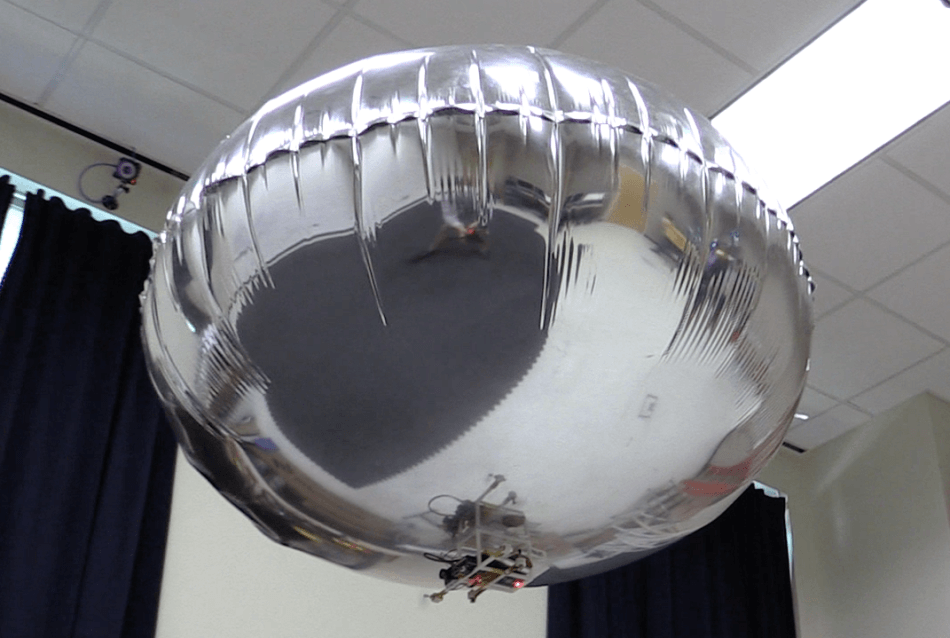May 16 2017
 Autonomous blimps are controlled by a 3D-printed gondola frame that carries sensors and a mini camera. It attaches to either an 18- or 36-inch diameter balloon. (Credit: Georgia Institute of Technology)
Autonomous blimps are controlled by a 3D-printed gondola frame that carries sensors and a mini camera. It attaches to either an 18- or 36-inch diameter balloon. (Credit: Georgia Institute of Technology)
Researchers at Georgia Institute of Technology have developed new free-flying robots that follow the two rules of the air — don’t undercut or collide with each other. In addition to these robots, the researchers have also developed autonomous blimps that can detect faces and recognize hand gestures.
The team will present these two projects at the 2017 IEEE International Conference on Robotics and Automation (ICRA), which will be in Singapore between May 29 and June 3, 2017.
In the first project, five swarm quadcopters move back and forth in formation and then modify their behaviors according to users’ commands. However, the quadcopters should be maneuvered in such a way that they do not bump into one another or fly under another machine. When the quadcopter cuts into the airstream of a higher flying robot, the lower machine should immediately recover from the turbulent air, or else it will fall out of the sky.
Ground robots have had built-in safety ‘bubbles’ around them for a long time to avoid crashing. Our quadcopters must also include a cylindrical ‘do not touch’ area to avoid messing up the airflow for each other. They’re basically wearing virtual top hats.
Magnus Egerstedt, Professor, School of Electrical and Computer Engineering, Georgia Tech
The Georgia Tech flying robots can swarm freely without any problems, but they should avoid flying in the two-foot space below their neighboring machine. This means instead of going low, they fly around each other.
One afternoon, Ph.D. student Li Wang found out the size of the “top hat” by hovering one quadcopter in the air while sending other machines back and forth below it. However, the machines crashed to the ground as soon as they came closer than 0.6 of a meter, or five times the diameter from one rotor to another. Wang then created algorithms, which allowed the machines to alter their formation midflight without crashing to the ground.
We figured out the smallest amount of modifications a quadcopter must make to its planned path to achieve the new formation. Mathematically, that’s what a programmer wants — the smallest deviations from an original flight plan.
Li Wang, Ph.D. Student, Georgia Tech
The first project is part of Wang and Egerstedt’s overall research, which mainly focuses on interacting and controlling with large teams of robots.
“Our skies will become more congested with autonomous machines, whether they’re used for deliveries, agriculture or search and rescue,” said Egerstedt, who directs Georgia Tech’s Institute for Robotics and Intelligent Machines. “It’s not possible for one person to control dozens or hundreds of robots at a time. That’s why we need machines to figure it out themselves.”
The research team, who handles the second project called the blimps, first 3D-printed a gondola frame that carries a mini camera and sensors. This frame adheres to a balloon that measures 18- or 36-inch in diameter. The larger blimp can support 20 g, while the smaller one can carry a payload of 5 g.
The autonomous blimps are designed to detect faces and hand movements, enabling people to guide the flyers with movements. While flying, the machines collect all the information about its human operator, detecting everything from eager smiles to hesitant glares. The aim of the project is to gain a better understanding of the interaction between humans and flying robots.
“Roboticists and psychologists have learned many things about how humans relate to robots on the ground, but we haven’t created techniques to study how we react to flying machines,” said Fumin Zhang, the Georgia Tech associate professor leading the blimp project. “Flying a regular drone close to people presents a host of issues. But people are much more likely to approach and interact with a slow-moving blimp that looks like a toy.”
While the circular shape of the blimps makes it harder to steer them with manual controllers, it enables them to turn and rapidly change direction. This is different from the more prominent zeppelin-shaped blimps that are often employed by other researchers.
Zhang has already filed a request with Guinness World Records for the world’s smallest autonomous blimp. He envisages a future where blimps can play a major role in human lives, but this feat can be realized only if roboticists establish the exact requirements of people and how they will respond to a flying companion.
Imagine a blimp greeting you at the front of the hardware store, ready to offer assistance. People are good at reading people’s faces and sensing if they need help or not. Robots could do the same. And if you needed help, the blimp could ask, then lead you to the correct aisle, flying above the crowds and out of the way.
Fumin Zhang, Associate Professor, Georgia Tech
Quadcopters swarm safely in tight formation
Five swarm quadcopters zip back and forth in formation, then change their behaviors based on user commands — with no crashes.
Autonomous blimp detects faces and hand movements
Tiny 3D-printed gondolas are attached to 18- or 36-inch blimps. The frames carry sensors that can detect faces and follow them.